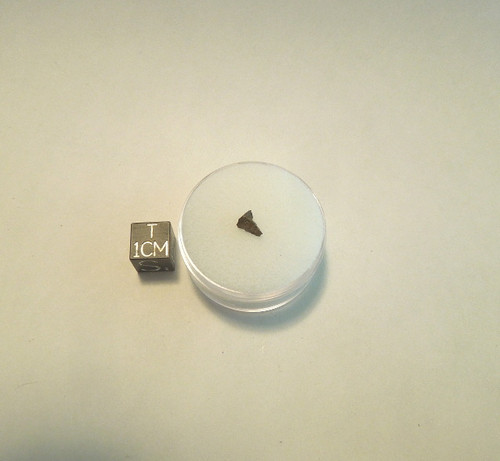The NWA 801 meteorite was first recovered out of Morocco during the early part of the Saharan Gold Rush in 2001. It was analyzed and classified as a rare carbonaceous CR2 type meteorite. This meteorite represents a sample of an asteroid that rained down on Earth long ago. Recent scientific studies have shown that in additon to metal, silicates, and exotic minerals, this meteorite also contains some of the basic building blocks of life - amino acids and sugar in the form of ribose. The samples I am offering were acquired by me from the original owner of this meteorite who first brought it to market. These are small cut/windowed fragments that show interior features on a small scale. They would be ideal for study or collecting.
Refer to the photo. The black centimeter cube is shown for scale and is not included. You are purchasing a single small fragment like the one shown. Your purchase will include a labeled gemjar for safe storage. The fragment you receive may be larger than the example shown. I used a smaller fragment for the photo - your specimen will be at least this big or bigger.
Note, you can read the recent NASA press release about the findings of sugar and amino acids at this link : https://www.nasa.gov/press-release/goddard/2019/sugars-in-meteorites
From the Meteoritical Bulletin entry on NWA 801 :
Northwest Africa 801
Morocco
Find: 2001
Carbonaceous chondrite (CR2)
History: M. Farmer and G. Hupe recovered a total of approximately 5 kg of many individuals and fragments from Zagora, Morocco. Many whole and sliced specimens have been sold over the last several years.
Physical characteristics: Many whole stones and fragments, all with desert varnish and brown/orange color. Numerous chondrules, many on the order of ~ 1 mm in apparent diameter, are visible.
Petrography: (G. Benedix and C. Smith, NHM) The thin section studied is dominated by millimeter-sized Type I PO and POP chondrules, which are often rimmed with and/or contain metallic Fe-Ni blebs. Metallic Fe-Ni also occurs as rounded, millimeter-sized grains within the matrix. Interstitial to chondrules and metal is a fine-grained matrix rich in phyllosilicate.Two Type II chondrules were also observed. Pervasive veins of rust occur throughout.
Classification:Carbonaceous chondrite (CR2); moderate to extensive weathering.





